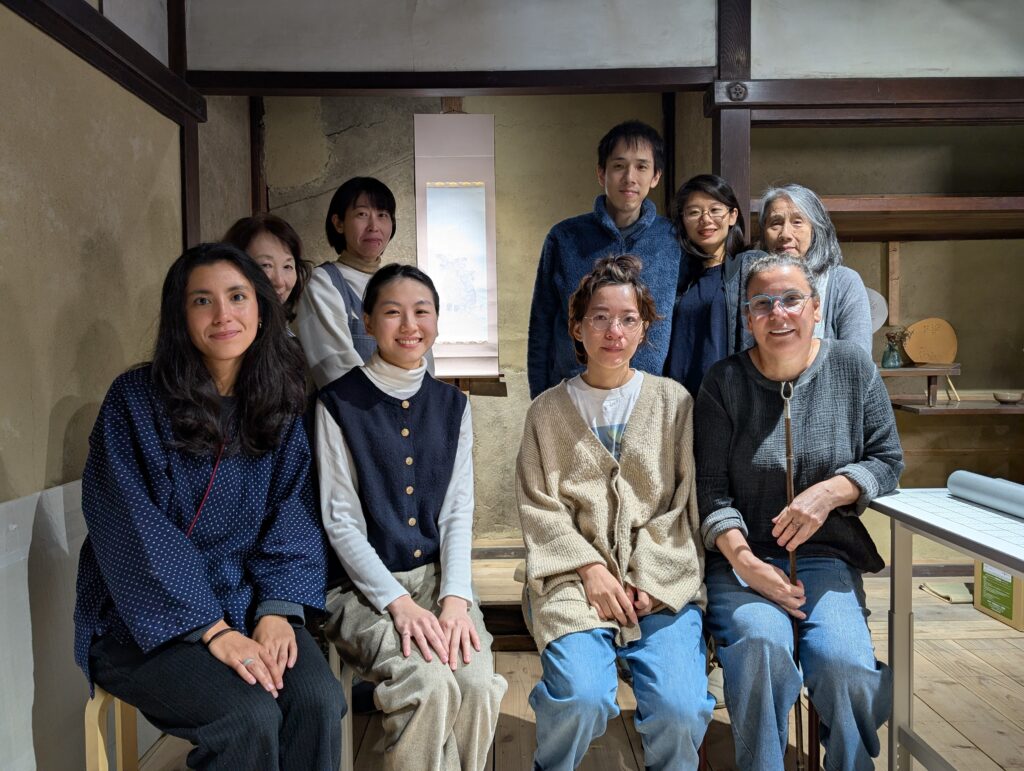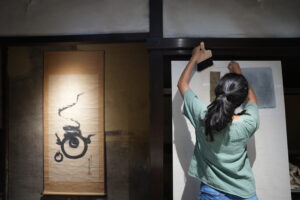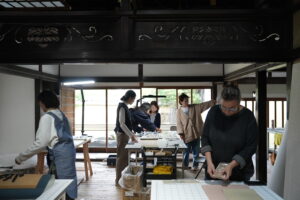
2026 Hyogu Residency
The Art of Paper Mounting and Framing
2026 Program Dates
- Spring: May 9th to June 5th
- Autumn: November 7th to December 4th
Program Overview
Hyogu – The Art of Paper Mounting and Framing is an artist-in-residence program for artists and practitioners who want to pursue a deeper understanding in the art of hyogu, and learn the practical techniques to mount two pieces of kakejiku hanging scrolls instructed by experienced hyogu mounters from century-old mounting studio, Seikadou. Artists in the program are encouraged to intergrate what they learned from the program in their future art practices and personal projects.
What is Hyogu?
Hyogu (表具) is the art of mounting and framing of paper-based artworks. It has been practiced in Japan since the 8th century in the realms of painting, calligraphy and prints ranging from contemporary art to historic cultural assets in the field of restoration and conservation.
The essence of a hyogu lies in the harmonious combination of honshi (the main artwork) and sotei (decorative mounting) which requires knowledge and skills in mounting and an appreciation for aesthetics.
Highlights
- Hyogu and Kakejiku for Artists — designed for artists and practitioners seeking both a foundational understanding of hyogu and hands-on skills in mounting kakejiku hanging scrolls.
- Guided Kakejiku Scroll Mounting Lessons — from start to finish
- Under the guidance of professional mounters from Seikadou, each artist will complete mounting two kakejiku using the traditional technique.
- Build a foundational knowledge in Japanese style kakejiku mounting, including the aesthetics, formats, systems, materials, tools, and the essential techniques.
- Mounting personal artworks is possible, further instructions will be provided after enrolling the program.
- Hyogu Mounting Tools — selected by professional mounters, this valuable set of mounting tools will belong to the artist to support their future mounting practices.
- Hyogu Handbook — an English language handbook dedicated to kakejiku mounting techniques.
- Nara Paper and Sumi Ink — an exclusive opportunity to explore the paper and sumi ink crafted in Nara—both materials closely related to hyogu.
- Curated Field Trips — to local studios, material suppliers, and cultural sites to deepen your understanding of hyogu and the traditional craftsmanship behind this art form.
- Dedicated Studio Environment — each artist will have a personal work desk in a shared studio, with all the necessary tools and materials to mount two kakejiku.
- 4-weeks Accommodation in Toma House AIR – choose between staying in the 18-century historic Toma House, or in the newly renovated annex Toma Beige next door.
This Program is For
- Artists, craftspeople, curators, researchers, designers, and individuals who are interested in learning the art of hyogu, with a focus on the mounting technique kakejiku (hanging scrolls).
- No prior experience in Hyogu is required, but a strong interest in hand mounting, mounted paper artworks or conservation is recommended.
2026 Program Fees
The program fee vary from the building/room selected by the applicant, please refer to our Application Guidelines below for accommodation, program fees, and Q6 in the FAQ section below for more details:
- Spring Session: 2026 spring-only special campaign offer
- From 693,000 yen for rooms in Toma Beige
- From 748,000 yen for rooms in Toma House
- Autumn Session: standard program price
- From 793,000 yen for rooms in Toma Beige
- From 848,000 yen for rooms in Toma House
- Notes for artists applying for external grants and funding:
- Once a place is offered to you, we will be happy to prepare necessary documents to support your funding applications.
- To allow enough time to secure external funds, early submission and preparation are strongly encouraged to keep your place.
File: 2026 Hyogu Residency Guidelines, Accommodation and Program Fees
URL: https://drive.google.com/file/d/1w6S3KiIbu-UOqdiBDvfd9vXs9I5t-Iz1/view?usp=sharing
Application Procedure
- Please read and understand the above Application Guidelines before starting the application.
- Fill in the Online Application Form
- Spring Session: May 9th to June 5th
- Autumn Session: November 7th to December 4th
- Application Form URL – https://docs.google.com/forms/d/e/1FAIpQLSdt1Lcu_szfem1BqYEA8P1jcm-lUR9S_6kUKtNttJcd3Jwanw/viewform?usp=dialog
- An application confirmation e-mail will be sent to you.
- Once you are selected to join the program, we will send you an invitation agreement, followed by the program invoice
- Application End Dates:
- Spring Session: 30th Jaunary, 2026
- Autumn Session: May 9th, 2026
- Early application is encouraged, as candidates are accessed and offered places on a rolling-basis
Instructor Profile
SEIKADOU
SEIKADOU CO. LTD., established in Osaka in 1923, is a mounting studio dedicated to the art of mounting and preserving historical and artistic works.
As the primary instructor of the program, their expertise will guide you through the ways to appreciate hyogu and master the steps and techniques to mount kakejiku.
Their mounters are experts in mounting and framing various art forms, from historic hyogu collections in temples and museums to contemporary artworks. They are committed to advancing artwork preservation technologies, digital archiving; and nurturing the next generation of mounters. SEIKADOU had been selected to exhibit in the 2025 World Expo in Osaka.
Program Special Guest
BUNKAZAIHOZON CO. LTD.
Nara-based Bunkazaihozon Co. Ltd. is one of only ten studios in Japan accredited by the Association for Conservation of National Treasures (ACNT) to preserve and restore national treasures.
The studio specializes in restoring oriental paintings and books that are registered national treasures or significant cultural properties. They wish to impart to participants a deeper understanding of cultural properties, the importance of conservation and restoration, and the intricate structure and features behind the artworks.
https://www.kokuhoshuri.or.jp/en/kobo/bunkazai.html
Nara Sumi Ink – Artist and Instructor
CHRISTINE FLINT SATO
Christine Flint Sato is a British sumi ink painter based in Nara, the centre of sumi ink production in Japan.
Captivated by the beauty of sumi ink arts, she studied shodo (calligraphy) under Japanese calligrapher Seika Kawabe and suibokuga (ink painting) under Chinese ink painter Li Geng. Her artwork is in gallery and private collections. It is abstract and inspired by the natural world. The sumi ink medium itself is organic and vibrantly alive, offering limitless potential for exploration.
Parallel to her studio work, she researches and writes about the sumi ink arts. She is keen to share about them and their practice. She published ‘Japanese Calligraphy: The Art of Line and Space’ in 1999 and ‘Sumi Workbook’ in 2014.
In the workshop she will introduce you to core techniques based on the sumi ink art traditions, while supporting you in exploring the medium for yourself and your own artwork.
Important Notes
- Due to the competitive selection and a rolling-based selection, we encourage early applications to secure your place.
- This is a self-funded residency program. Participants will finance themselves throughout the program.
Hyogu Mounting Tools and Materials




Frequently Asked Questions
Q1: What is the program structure?
- 11 days of lessons held 2-3 times on weekdays
- 8 days of kakejiku mounting instruction
- 2 days of lessons and workshops to explore Nara sumi ink painting
- 1 day special lecture from Bunkazaihozon
- 5 field trips related to hyogu, mounting materials, and Nara traditional crafts such as sumi ink and paper
- The remaining days are free for rest, self-guided studio practice, or exploration in and around Nara.
Q2: What does the program fee cover?
- 4-week (28 days) accommodation in a private bedroom
- Shared studio, kitchen, toilet, shower, and laundry facilities
- Kakejiku mounting instructions and lessons about hyogu by professional mounters
- A bilingual English-Japanese interpreter during lessons
- Lessons and workshops on Nara’s sumi ink painting
- Field trips
- A valuable set of hyogu mounting tools and an English-language Hyogu Handbook
- All the necessary kakejiku mounting materials to mount two standard kakejiku
Q3: What is not covered?
- Travel and transportation
- Food
- Insurance and visa
- Customisation of mounting parts for the artist’s own artwork – such as bigger-sized artworks, etc.
- Additional mounting materials and tools for future practice – see Q4
- Personal expenses such as packing and shipping fees
Q4: Where can I buy additional mounting materials or tools for my future practices?
The hyogu mounting tools and materials provided during the program are sufficient for two standard-sized kakejiku. For artists who wish to stock up more materials for their future practices after the residency, it is possible to purchase additional materials, tools, and fabrics from Seikadou, or from local shops during their stay in Japan.
Q5: How many kakejiku will I learn to mount? Do I need to bring my own artwork to practice?
During the residency, each artist will learn to mount two kakejiku:
- First scroll: a practice piece using the template artwork provided by Toma House AIR.
- Second scroll: either another template or your own work. Artists bringing their own work must ensure:
- Maximum artwork width: 600 mm
- The paper must be thin enough to be rolled-up repetitively to become a kakejiku.
- Pigments/paints that can withstand repeated soaking, gluing and drying during the mounting process.
- Further instructions will be provided after enrollment
- For larger or longer artworks requiring extra fabrics, backing papers, or special materials, additional fees may apply for customised mounting materials from SEIKADOU.
Q7: What are the accommodation options?
Toma House AIR is composed of two buildings sharing the same garden:
- Toma House – The 18th-century Former Priest Family House
- A registered Intangible Property of Japan. This house can host up to two artists and has a big studio which can serve as a gallery, classroom, and performance space. The house is conserved following the traditional architecture craftsmanship specific to a Shake Architecture (the traditional residence of Shinto shrine priest families), and parts of the house is still in its own cycle of restoration, ideal for those who appreciate the beauty of an old Japanese traditional house.
- Toma Beige – The Annex
- A 2025 renovated annex next to Toma House. This house can host up to three artists.
- Notes:
- Please refer to the Program Guidelines for details about the bedrooms.
- Shared facilities of two buildings include the studios, kitchens, toilets, showers and laundry facilities.
- To safeguard the historic wooden house together, all artists and visitors are required to follow our non-smoking policy and house rules.



